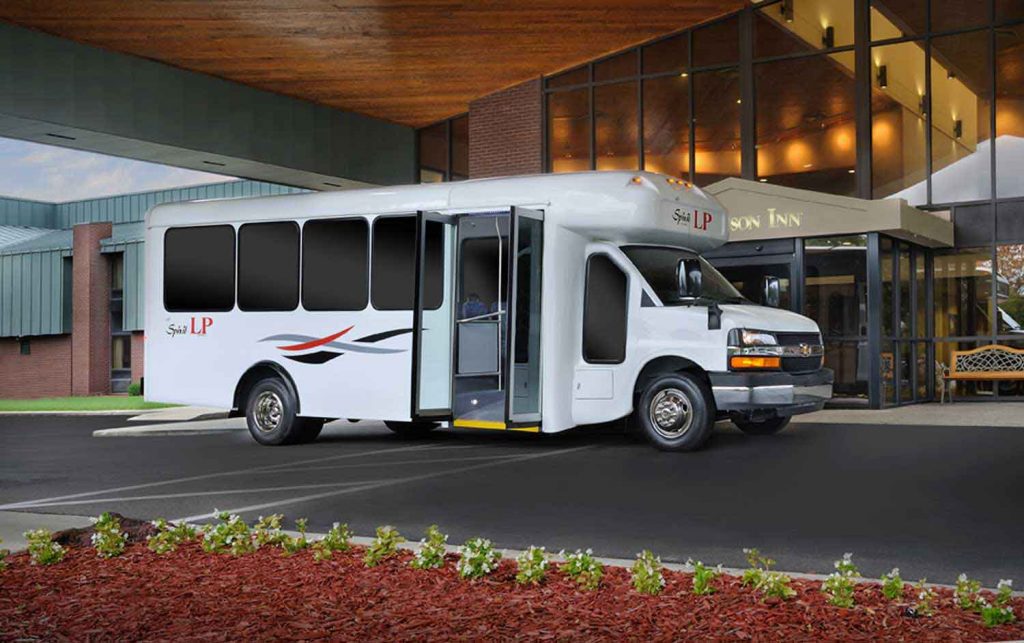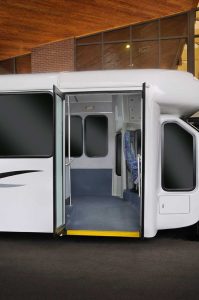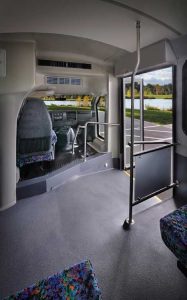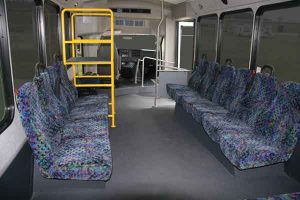
ARBOC Mobility introduces the Spirit LP to private markets
By David Hubbard

ARBOC Mobility, Middlebury, IN, worked eight years to perfect its concept of the low-floor paratransit bus it calls the Spirit of Mobility, conceived to provide easy and equal access for all passengers. This year ARBOC Mobility is bringing the exclusive features of the Spirit of Mobility to operators in private markets with its introduction of the Spirit LP.
When the Spirit of Mobility debuted two years ago, ARBOC President Jim Bartel announced his new company not only complied, but also fully embraced the spirit and intent of the Americans with Disabilities Act (ADA).
With proprietary low-floor engineering tailored for private markets, the Spirit LP comes prepped for ADA-compliant components as needed by its final customers.
“Every type of bus passenger appreciates low-floor access,” says Don Roberts, ARBOC vice president, sales and marketing. “There is a major void in the small bus market for this type of vehicle at the retail level.”
ARBOC Mobility says it does not take the approach that one bus fits all, but works to tailor its products for specific markets.

“The Spirit LP is a simpler product,” says Roberts. “But this vehicle also is less expensive than the Spirit of Mobility.”
ARBOC Mobility says it has been pleased by the number of North American transit authorities from Lubbock, TX to Calgary, AB, Canada that have purchased the Spirit of Mobility for actual transit applications as much as for paratransit.
“Transit agencies are especially interested in the low-floor accessibility for regular service,” says Roberts. “The features are ideal and the price certainly meets its shorter life cycle.”
ARBOC says to date public transit agencies across North America have purchased nearly 98 percent of the Spirit of Mobility vehicles it has assembled over the last 30 months. Roberts says the 400th ARBOC bus is on the line and Number 500 is in queue.
“We successfully met our own challenge to develop a rear-wheel drive, low-floor cutaway bus with an entry ramp and no steps anywhere in the passenger area,” says Bartel. “We did it without relying on a drop-box transfer case.”
However, the private market does not require all of the features present in the current Spirit of Mobility product. The Spirit LP specifically addresses these differences.

Many of the same standard features appear on the new ARBOC product, which include an integrated steel structure body-on-chassis construction with full E-Coat corrosion protection, as well as the proprietary Bolt-n-Bond assembly process, which greatly reduces interior noise. The construction of the Spirit LP has been simplified.
“The typical small bus market has not seen a vehicle anywhere close to the Spirit LP,” says Roberts. “The Spirit LP is a simpler vehicle in design using the OEM chassis suspension rather than air ride, helping reduce the manufacturing costs.”
Other important differences separate the Spirit LP from its sibling. Built on a Chevrolet chassis the new model is available in 24-foot and 27-foot models. The 24-foot features a 165-inch wheelbase over the 159-inch configuration of the Spirit of Mobility. Three-leaf steel parabolic springs in the rear replace the air suspension of the original model. Where air suspension maintains an even height, the step-in height with the conventional suspension is 12 inches or less, depending on the overall weight of the loaded bus.
The Spirit LP does not kneel but still provides an entrance ramp slope better than the 1:4 ADA entrance/egress standard. Bartel states that the entry slope on the Spirit LP is 1:5 using a 62-inch ramp. All entrance ramps for ARBOC products are the best in the industry at 34-inch width and 800-pound capacity. All wheelchair positions in the Spirit LP are enlarged to a 54-inch length. The entrance door width was also increased to 41 inches to allow people with luggage easier entrance and exit.

“For this new vehicle we are providing up to five wheelchair positions,” says Bartel. “These can be configured for random access just like the original Spirit of Mobility product. As the guiding principle behind the engineering, random access makes room for three, four, or five wheelchairs to maneuver easily inside depending on the model length.
“It is no longer about squeezing wheelchair passengers into a bus,” says Bartel. “Now it is how to best configure the usable space for the totally free flow of people moving on and off the bus.”
The Spirit LP also offers configured perimeter floor plans with up to three wheelchair positions. Perimeter seating is popular with parking and hotel shuttle operations.
The Spirit LP is only available with gasoline powertrains and features a reduced version of the Cooper-Bussman solid state electrical system typically used in class-A trucks. Roberts says the Spirit LP also comes with fewer options available on the Spirit of Mobility, because this bus will go to entirely different markets such as parking, assisted living, car rental agencies and hotels.
In July ARBOC Mobility held its dealer and vendor seminar in Auburn Hills, MI to introduce the new Spirit LP and to relate the improvements to the Spirit of Mobility bus. “The dealers thought the new Spirit LP was a tremendously important addition to the line-up and are anxious to start selling it,” says Roberts. “They liked the fact that ARBOC Mobility will only build low-floor buses”
Bartel points out that in less than three years ARBOC Mobility has become North America’s largest producer of mid-size buses under 30 feet.
“This goes to show that the industry is ready for a less expensive low-floor bus,” he says. “Until now a vehicle of this type has not been available.” BR

These buses are garbage. They are not capable of doing what they claim and are always broken down. The seats rattle the blind spots are ridiculous. They will fall about in two years. The only reason cities are buying them is because they are the cheapest alternative.